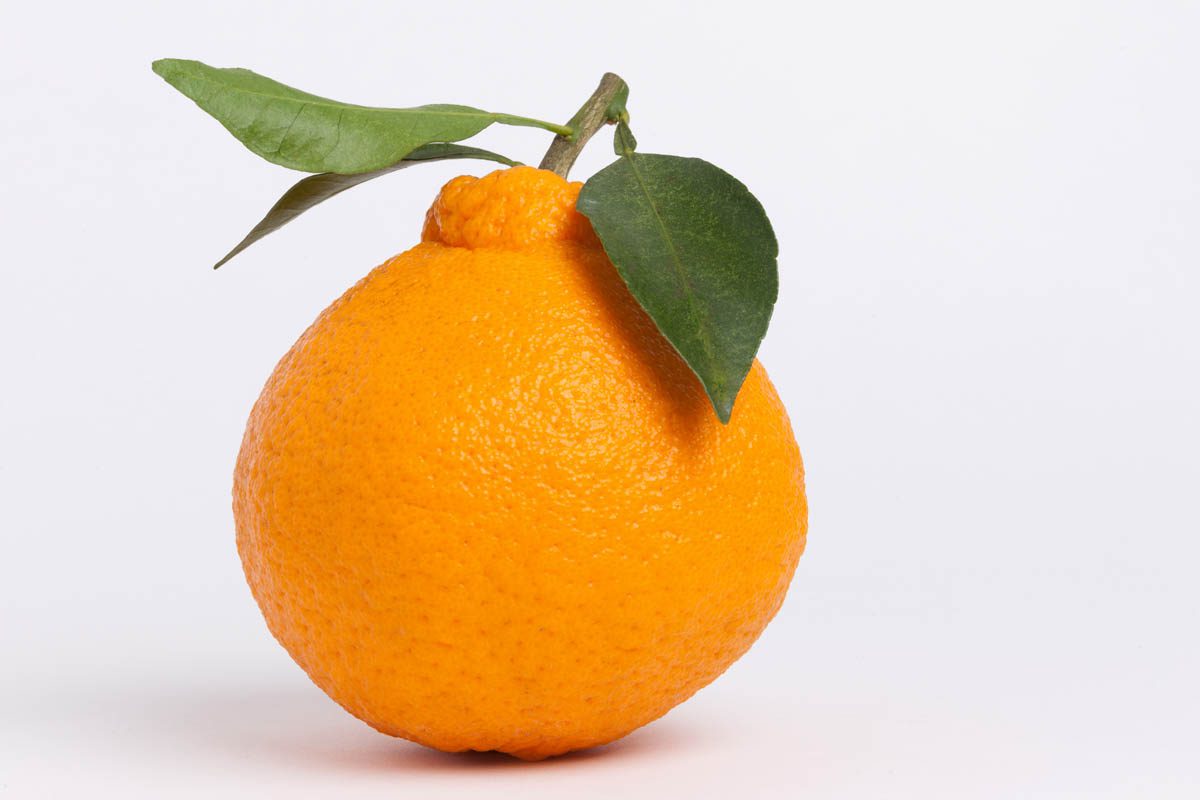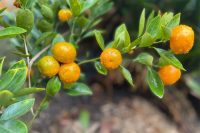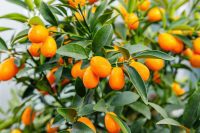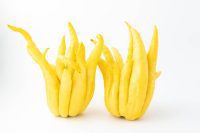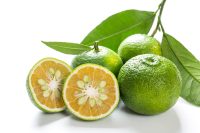Dekopon (Citrus reticulata ‘Shiranui’) is a sweet, seedless mandarin hybrid that was developed by crossing the Ponkan or Chinese honey orange (Citrus poonensis) with the Kiyomi (Citrus unshiu × sinensis).
The fruit of the dekopon ranges from 8-10 cm in diameter, with a round shape and a distinct bulge on the top that is sometimes referred to as a top knot. The bumpy skin is bright orange and approximately 4.8 mm thick, and beneath is a thin layer of pith, which protects the delicate hesperidium (sectioned) pith.
Dekopon is a portmanteau made up of deko which means bump or uneven and pon, in reference to the ponkan mandarin.
Names:
- Dekopon (デコポン)
- Sumo citrus (outside Japan)
- Sumo mandarin
- Sumo orange
- Shiranui (generic name)
- Hallabong (South Korea)
Cultivation
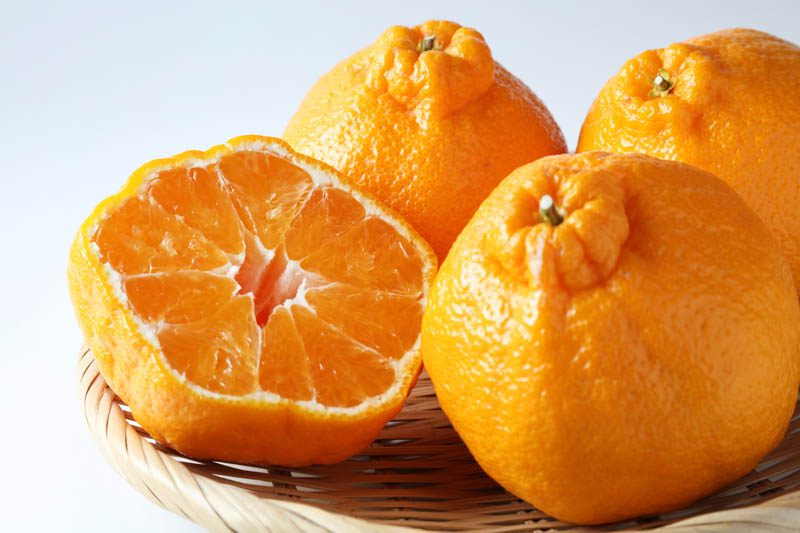
History
Dekopon is a species of citrus native to Japan where it is known for its sweet, almost seedless fresh and unique conical shape. The large fruit has a bright orange colour that is harvested in winter. Dekopon is considered to be one of the best-tasting citrus fruits, is highly prized in Japan and is given as a gift or used in high-end culinary dishes.
Dekopon was developed in 1972 by the Agricultural Research Organisation, Nagasaki Prefecture. The goal was to produce an easy-to-peel, sweet citrus with no seeds. Initially, the fruit was not registered due to the unattractive bump on the top and the sour taste of the fruit immediately after harvest. Seedlings were transported to Shiranui-cho, Uto-gun, Kumamoto Prefecture, where they grew in a test garden. Shingo Nagame, director of the experimental garden ate a dekopon that had been harvested and left out and found the fruit had developed a sweet taste.
Habitat
Dekopon thrives in regions with a subtropical to tropical climate. It requires warm temperatures for optimal growth, with average temperatures of 20 to 30 ºC (68 to 86º F) during the growing season. Frost can damage Dekopon trees, so regions with mild winters are preferred.
In Japan, Dekopon is mostly grown in greenhouses to ensure a constant temperature, year-round.
Production
Japan
Dekopon is primarily grown in Ehime, Wakayama, Hiroshima, and Kumamoto Prefectures. These areas have suitable climate conditions for citrus cultivation, including ample sunlight and well-drained soil.
The harvest season occurs from January to March, although the exact timing may vary depending on the region and weather conditions. Mature fruit weighs between 250-300 grams and is harvested by hand to avoid damage.
United States
Outside Japan, Dekopon is sold under the trademarked name Sumo Citrus, in a nod to the sumo wrestler, and is a licensed and controlled brand. Citrus farmer Brad Stark Jr. imported a budwood branch into the United States in 1998. The importation of citrus into the United States is mostly prohibited to protect local growers and prevent the introduction of pests and diseases. The cuttings Brad Stark Jr. imported were grown in quarantine for several years.
In the meantime, Brad Stark Jr. went bankrupt and Brad sold the rights to the Griffith family, who owned Suntreat. The development of Dekopon was kept under wraps until they could properly cultivate them and release a branded version, eventually settling for Sumo, presumably due to the fruit’s resemblance to a sumo wrestler. Dekopon fruit must be a certain size to be considered a Sumo citrus.
Due to the difficulty growing Dekopon, it took until 2011 before the fruit was released to the public.
Australia
Pacific Fresh in Leeton, NSW brought the Dekopon to 2003, and the first commercial harvest occurred in 2011. Fruit is available between June and August in Woolworths stores.
Brazil
Dekopon is also grown in Brazil, which produces 300 tonnes of fruit every year.
Growing Dekopon
Dekopon trees are primarily sold to commercial farmers and are unavailable to the general public. Some people have attempted to grow trees from seeds found in the flesh of the fruit, however, Dekopon has been selectively bred to yield seedless fruit, therefore the presence of seeds is rare.
Almost all citrus trees are grafted so that the tree is a clone of the parent plant. Citrus trees grown from seed won’t necessarily be the same stock as the parent. Dekopon exhibits polyembryony, which means the seeds give rise to multiple seedlings, each distinct from the parent plant. If you choose to cultivate Dekopon from seed, it’s important to note that the tree may take up to 15 years before bearing fruit.
It is important to take care when picking Dekopon to avoid damaging the skin and the top knob of the fruit.
Name
The generic name for Dekopon is ‘Shiranuhi’, which is named after the former town Shiranuhi (不知火町), located in Uto District, Kumamoto Prefecture which is now a part of Uki City.
Dekopon is a trademarked name owned by the Kumamoto Fruit Agricultural Cooperative Association. In Hiroshima, the Dekopon is marketed as Kiyopon, and unlike Dekopon, this name doesn’t appear to be trademarked.
In South Korea, the Dekopon is known as ‘hallabong’, named after Hallasan Mountain on the island of Jeju, where the fruit is primarily grown. The flavour of Dekopon is described as a cross between an orange and a mandarin. A thin membrane covers the segments, which are firm, juicy and sweet with a hint of tartness. The flesh is typically seedless and tender.
Flavour
The taste of Dekopon is described as between that of a mandarin and an orange. The fruit is sweet and juicy, with a juice content of 40-50%, and is low in acid. Before consuming, always remove the stringy, bitter, white pith that is attached to the segment membrane.
Brix refers to the sugar content in citrus fruits. While all Dekopons are ‘Shiranuhi’, not all Shiranuhi are Dekopon. For the fruit to be called Dekopon, it must reach a minimum of 13 Brix but can be as high as 18 with 1.0% citric acid levels. For comparison, oranges have an average Brix level of 10 and limes 6.
Chemistry
- Vitamins: Dekopon, like other citrus fruits, is rich in essential vitamins, particularly vitamin C (ascorbic acid), a potent antioxidant.
- Flavonoids: Citrus fruits contain flavonoids. Flavonoids are antioxidants known for their potential health benefits, including anti-inflammatory and cardiovascular protective effects. Flavonoids also contribute to the colour and flavour of the fruit.
- Sugars: Dekopon is known for its high sugar content, primarily in the form of sucrose, glucose, and fructose, which give the fruit its characteristic sweetness.
- Sugars: Dekopon is known for its high sugar content, primarily in the form of sucrose, glucose, and fructose, which give the fruit its characteristic sweetness.
- Essential Oils: Dekopon contains essential oils, responsible for their aroma and flavour. These oils are composed of various volatile compounds, including limonene, linalool, and citral.
- Pectin: Pectin is a type of soluble fibre found in the peel and membranes of citrus fruits. It helps to regulate digestion and may have other health benefits, such as cholesterol reduction.
- Carotenoids: Carotenoids are pigments responsible for the orange colour of Dekopon and other citrus fruits. They have antioxidant properties and are precursors to vitamin A, which is important for vision health and immune functions.
Uses
Dekopon is a versatile fruit that can be enjoyed both raw or cooked.
- Fresh: Peel the fruit and enjoy the juicy and sweet flesh.
- Juice: Squeeze the fruit to make a sweet juice that can be enjoyed on its own or in cocktails.
- Liqueurs: Remove the zest from the fruit, take care to avoid the bitter white pith underneath. Combine the zest with vodka in a large glass jar and let it sit in a cool, dark place for 7-10 days. Strain the vodka mixture to remove the zest. Make a simple syrup by combining 1 litre of water with 1 kg of sugar, and heat over medium heat until dissolved. Once it has cooled, combine the simple syrup with the vodka mixture to make a Dekopon ‘limoncello’.
- Desserts and cakes: Dekopon rind, juice and segments can be added to desserts, cakes and icing for a sweet, refreshing taste.
- Salads: Finely grated zest can be added to salad dressings and fresh fruit segments go well in salads.
- Marinades: Blend Dekopon fruit with soy sauce, vinegar, honey, and garlic for a sweet and savoury baste for red meat, poultry, or seafood.
- Sushi: Dekopon can be used as a substitute for traditional citrus as a topping for sushi rolls. The sweet and slightly acidic flavour compliments the salty and savoury flavours of the rice and other ingredients. The fruit is typically sliced thinly and arranged on top of the sushi roll.
Storage
Store Dekopon the same way as other citrus varieties.
- Room temperature: Dekopon will last approximately a week at room temperature. Store away from direct sunlight and heat sources.
- Cooler temperature: For longer storage, store them in the refrigerator, where the fruit will last several weeks.
Note: Do not store citrus near fruits and vegetables that produce ethylene gas, such as apples, bananas, and tomatoes, as this can cause the fruit to ripen and deteriorate more quickly.
Recipes
Dekopon simple syrup |
Ingredients:
Method:
This syrup can sweeten and add a citrus flavour to cocktails, teas, lemonades, and other beverages. It can also be drizzled |
Dekopon citrus salad |
Ingredients:
Method:
|
Dekopon sorbet |
Ingredients:
Method:
|
Dekopon marmalade |
Ingredients:
Method:
|
Dekopon salsa |
Ingredients:
Method:
|
Dekopon chicken |
Instructions:
Method:
|
Dekopon lemonade |
Ingredients:
Method:
|
Dekopon cake |
Ingredients:
Method:
|
Dekopon panna cotta |
Ingredients:
Method:
|
Julia is a writer and landscape consultant from Wollongong with a love of horticulture. She had been an avid gardener for over 30 years, collects rare variegated plants and is a home orchardist. Julia is passionate about learning and sharing her knowledge of plant propagation and plant toxicology. Whether it’s giving advice on landscape projects or sharing tips on growing, Julia enjoys helping people make their gardens flourish.
